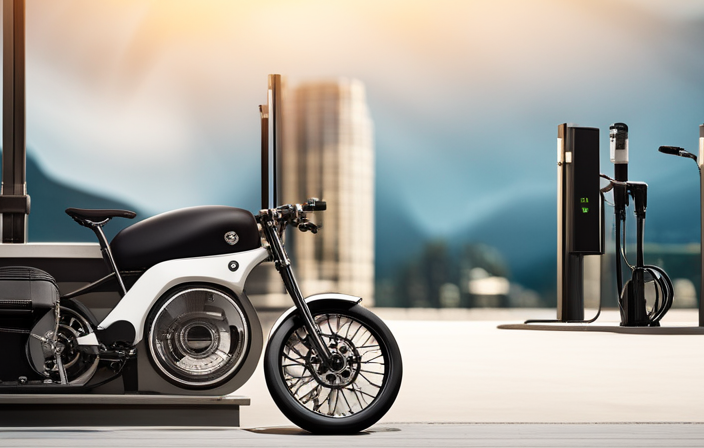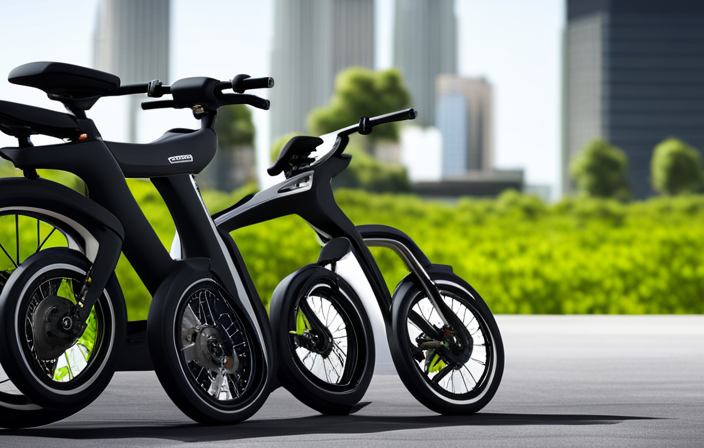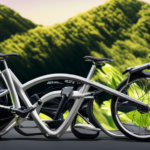Did you know that the average electric bike battery can last anywhere from 20 to 50 miles on a single charge?
With the increasing popularity of electric bikes, it’s important to understand how often you should charge your bike to maximize its battery life and performance.
In this article, I will provide you with a comprehensive guide on the factors affecting battery life, general charging guidelines, best practices, and tips for optimal battery performance.
So, let’s dive in and learn how to keep your electric bike charged and ready to go!
Key Takeaways
- Lithium-ion batteries have higher energy density and longer lifespan compared to lead-acid batteries.
- Usage patterns, extreme temperatures, and consistent charging to recommended levels affect battery life.
- Charge the electric bike after each ride, especially if significant power was used, and avoid overcharging.
- Use a Battery Management System (BMS) to monitor battery voltage and capacity, optimize charging frequency, and enhance safety.
Understanding Battery Types and Capacities
Understanding battery types and capacities is crucial when determining how often to charge your electric bike. To determine the optimal battery charging frequency, it is important to have a good understanding of battery technology.
Electric bike batteries come in different types, such as lithium-ion and lead-acid, each with their own unique charging characteristics. Lithium-ion batteries, for example, have a higher energy density and can hold more charge, while lead-acid batteries are less expensive but have a lower energy density.
Additionally, the battery capacity is an important factor to consider. The higher the capacity, the longer the battery can provide power before needing a recharge.
By understanding these battery types and capacities, you can determine the appropriate charging frequency for your electric bike.
Factors affecting battery life will now be discussed.
Factors Affecting Battery Life
To maximize your battery life on an e-bike, it’s important to consider various factors. Here are four key factors affecting charging frequency and maximizing battery lifespan:
-
Usage Patterns: The more frequently and intensively you use your electric bike, the more often you’ll need to charge the battery. High-speed riding, frequent hill climbs, and long distances can all drain the battery faster.
-
Temperature: Extreme temperatures, both hot and cold, can significantly impact battery performance and lifespan. It’s best to avoid exposing your e-bike to extreme temperatures whenever possible.
-
Battery Type and Capacity: Different battery types and capacities have different charging needs. Understanding the specific requirements of your battery and following the manufacturer’s guidelines can help prolong its lifespan.
-
Charging Habits: Consistently charging your battery to the recommended level and avoiding frequent partial charges can help maintain its health and longevity.
Considering these factors will help you determine the optimal charging frequency for your electric bike. Now let’s delve into general charging guidelines to further optimize your battery’s performance.
General Charging Guidelines
To optimize your battery’s performance, it’s important to follow general guidelines when charging. Battery maintenance plays a crucial role in ensuring the longevity of your electric bike’s battery.
When it comes to charging frequency, it is recommended to charge your electric bike after each ride, especially if you have used a significant amount of power. This helps to prevent the battery from fully discharging, which can negatively impact its overall lifespan. However, it is also important to avoid overcharging your battery, as this can lead to decreased performance over time. It is generally recommended to unplug the charger once the battery is fully charged.
By following these charging guidelines, you can ensure that your battery remains in optimal condition for longer periods of time.
Transitioning into the next section, monitoring battery life and performance allows you to assess any potential issues and take necessary steps to maintain your electric bike’s battery.
Monitoring Battery Life and Performance
When it comes to monitoring battery life and performance on my electric bike, I always make sure to use a Battery Management System (BMS) if available.
This system helps me keep track of the battery’s voltage and capacity, allowing me to make informed decisions about charging and usage.
Additionally, I continuously monitor my battery for any abnormalities or decreased performance, so that I can address them promptly and ensure optimal functioning.
Use a Battery Management System (BMS) if Available
If you have a Battery Management System (BMS) available, you should definitely use it to ensure optimal charging for your electric bike. A BMS is a crucial tool that helps monitor and control the charging process, maximizing battery life and performance.
Here are some benefits of using a BMS:
- Enhanced safety: A BMS protects against overcharging, undercharging, and overheating, reducing the risk of accidents or damage.
- Improved battery lifespan: By preventing overcharging and undercharging, a BMS helps extend the overall life of your battery.
- Efficient charging: A BMS ensures that the battery is charged at the right voltage and current levels, maximizing its charging efficiency.
- Accurate battery monitoring: With a BMS, you can easily monitor the battery’s voltage, capacity, and health, allowing you to make informed decisions about charging.
By utilizing a BMS, you can optimize your battery charging frequency and ensure the best performance for your electric bike.
Now, let’s discuss how to keep an eye on your battery’s voltage and capacity.
Keep an Eye on Your Battery’s Voltage and Capacity
To ensure optimal battery performance and longevity, it is crucial to keep an eye on your electric bike battery’s voltage and capacity. Monitoring these factors will give you valuable insight into your battery’s health and allow you to take appropriate actions for battery maintenance. A Battery Management System (BMS) can provide real-time information about your battery’s voltage and capacity, allowing you to make informed decisions regarding charging frequency. Additionally, regularly checking the voltage and capacity of your battery can help you identify any abnormalities or decreased performance, indicating potential issues that need to be addressed. Maintaining a healthy battery is essential for the overall performance and lifespan of your electric bike. By closely monitoring your battery’s voltage and capacity, you can ensure its longevity and optimal performance.
| Voltage Level | Battery Capacity | Action Required |
|---|---|---|
| High | High | No action required |
| Low | High | Charge the battery |
| High | Low | Check for abnormalities |
| Low | Low | Charge the battery and check for abnormalities |
Continuing with battery maintenance, it is important to monitor and address any abnormalities or decreased performance to ensure the longevity and optimal functioning of your electric bike.
Monitor and Address Any Abnormalities or Decreased Performance
Keep an eye out for any abnormalities or decreased performance in your battery and take appropriate actions to address them. Regular battery maintenance is crucial for the optimal functioning of your electric bike.
Troubleshooting common issues can help identify potential problems and prevent further damage. Check for any leaks, corrosion, or loose connections in the battery compartment. If you notice any of these issues, tighten the connections or clean the affected area.
Additionally, monitor the battery’s voltage and capacity regularly using a multimeter to ensure it is within the recommended range. If you experience a significant decrease in performance or notice any unusual behavior, it may be necessary to replace the battery. By addressing these issues promptly, you can prolong the lifespan of your battery and maximize your electric bike’s performance.
Transitioning to the subsequent section about charging methods and best practices, it is essential to understand the importance of proper charging techniques.
Charging Methods and Best Practices
Charging your electric bike regularly and following best practices is essential for optimal battery performance. The battery charging frequency depends on various factors such as your riding habits, battery capacity, and the type of charger you use.
Generally, it is recommended to charge your electric bike after each ride or when the battery level drops to around 20-30%. This helps prevent a complete discharge, which can negatively impact the battery’s lifespan.
When charging, it is important to use the charger specifically designed for your electric bike model and avoid using fast chargers or chargers with higher voltage than recommended. Additionally, it is advisable to avoid charging your battery in extreme temperatures and to unplug it once fully charged to prevent overcharging.
Following these optimal charging techniques will ensure your electric bike’s battery remains healthy and performs optimally in the long run, as we will discuss in the subsequent section about long-term storage and maintenance.
Long-Term Storage and Maintenance
When it comes to long-term storage and maintenance of my electric bike, there are a few key points I always keep in mind.
First and foremost, I make sure to properly store my battery when it’s not in use. This means storing it in a cool, dry place away from direct sunlight and extreme temperatures.
Secondly, I avoid fully discharging the battery if I plan on storing it for an extended period of time, as this can lead to irreversible damage.
Lastly, I make it a point to regularly clean and inspect my battery to ensure optimal performance and longevity.
Properly Store Your Battery When Not in Use
To properly store your battery when it’s not in use, it’s important to ensure that it is stored in a cool and dry place. This will help prevent any damage caused by extreme temperature or moisture. Additionally, it is crucial to keep the battery at a partial state of charge, around 40-60%, during long-term storage. This helps to prevent the battery from self-discharging too much or being overcharged.
To further illustrate the importance of proper battery storage, consider the following table:
| Battery Storage Tips |
|---|
| Store in a cool and dry place |
| Keep battery at a partial state of charge |
| Check battery voltage periodically |
By following these guidelines, you can ensure that your battery remains in good condition during periods of non-use. It’s important to avoid full discharge if storing for an extended period, as this can lead to irreversible damage. Transitioning into the next section, it is crucial to understand the impact of full discharge on battery longevity and performance.
Avoid Full Discharge if Storing for an Extended Period
Make sure you don’t let your battery fully discharge if you plan on storing it for a long period of time. Avoiding deep discharge is crucial to maintaining the health and longevity of your electric bike’s battery.
Here are three reasons why regular charging is important:
-
Prevents capacity loss: Lithium-ion batteries, commonly used in electric bikes, can experience irreversible capacity loss if left in a discharged state for too long. By regularly charging your battery, you can prevent this loss and ensure optimal performance.
-
Extends battery life: Deep discharge can lead to increased internal resistance and chemical changes within the battery, reducing its overall lifespan. Regular charging helps to avoid these issues and prolong the life of your battery.
-
Ensures readiness: By keeping your battery charged, you can be confident that your electric bike is always ready for use whenever you want to hit the road.
To maintain your battery’s performance and safety, it is also important to regularly clean and inspect it.
Regularly Clean and Inspect Your Battery
Take the time to regularly clean and inspect your battery to ensure its performance and safety. Proper maintenance of your electric bike battery is crucial for its longevity and efficiency.
To clean your battery, start by detaching it from the bike and using a soft cloth or sponge to wipe away any dirt or debris. Avoid using water or any harsh cleaning agents that may damage the battery.
Additionally, check for any signs of wear or damage such as cracks or leaks. If you notice any issues, it is important to consult a professional for repairs or replacements.
Following these battery cleaning techniques and maintenance tips will help extend the life of your battery, ensuring optimal performance for your electric bike.
Extending Battery Life
You should avoid fully depleting the battery on your electric bike, as it can help extend its overall lifespan. Maximizing efficiency and managing power consumption are key factors in extending the battery life of your electric bike.
To achieve this, you can start by using the appropriate power mode for your riding conditions. Lower power modes can help conserve battery power and increase the distance you can travel on a single charge.
Additionally, maintaining a steady and consistent speed rather than frequently accelerating and decelerating can also help optimize power consumption. Furthermore, keeping your tires properly inflated and ensuring your bike is well-maintained can reduce rolling resistance and minimize energy loss.
By implementing these strategies, you can significantly prolong the life of your electric bike’s battery and enhance your overall riding experience. When it comes to battery replacement and upgrades, it is important to consider the different options available to you, which I will discuss in the next section.
Battery Replacement and Upgrades
When it comes to battery replacement and upgrades for my electric bike, there are a few key points to consider.
First, it’s important to be aware of the signs that my battery may need replacement, such as reduced range or decreased performance.
If I’m looking to increase the capacity of my battery, upgrading to a higher capacity option can be beneficial.
Lastly, consulting with a professional is crucial to ensure proper installation and compatibility with my electric bike.
Signs that Your Battery Needs Replacement
If your battery’s performance has significantly decreased, it’s likely time for a replacement. As batteries age, they may start to exhibit signs of degradation, indicating that it’s time to consider getting a new one. Some common signs include reduced range, longer charging times, and decreased power output. Additionally, if you notice that your battery is not holding its charge as well as it used to or if it suddenly drops in voltage during use, these are also indications that it may be time for a replacement.
To further emphasize the importance of recognizing these signs, here is a table showcasing the most common signs of battery degradation:
| Signs of Battery Degradation |
|---|
| Reduced Range |
| Longer Charging Times |
| Decreased Power Output |
| Poor Charge Retention |
| Voltage Drops During Use |
If you’re experiencing any of these issues, it’s time to consider upgrading to a higher capacity battery. This will not only improve your electric bike’s performance but also extend its overall lifespan.
Consider Upgrading to a Higher Capacity Battery
Consider upgrading to a higher capacity battery to enhance your electric bike’s performance and prolong its lifespan. Upgrading options for electric bike batteries are constantly evolving, offering better efficiency and longer-lasting power. Here are three reasons why you should consider upgrading:
-
Increased Range: A higher capacity battery allows you to go on longer rides without worrying about running out of power. You can explore new routes and enjoy extended adventures with confidence.
-
Improved Power Delivery: Upgrading to a higher capacity battery ensures a consistent and reliable power supply to your electric bike. This means you can tackle steep hills or challenging terrains with ease, thanks to enhanced battery efficiency.
-
Longer Lifespan: A higher capacity battery typically has a longer lifespan, reducing the frequency of replacements and saving you money in the long run.
By upgrading to a higher capacity battery, you can significantly enhance your electric bike’s performance. However, if you’re unsure about the best battery replacement option for your specific bike model, it’s always a good idea to consult with a professional for expert advice.
Consult with a Professional for Battery Replacement
When it comes to maintaining the performance of your electric bike, battery replacement is a crucial aspect to consider.
Over time, the capacity of your battery may diminish, resulting in decreased range and overall performance.
It’s important to consult with a professional when it comes to replacing your battery, as they can provide guidance on the best options available for your specific bike model.
They will be able to recommend a battery that suits your needs and ensure proper installation.
Additionally, they can offer valuable advice on battery maintenance, such as charging cycles and storage practices, to prolong the lifespan of your new battery.
By following their recommendations, you can optimize the performance and longevity of your electric bike.
Now, let’s delve into eco-friendly charging practices, which can further enhance your electric biking experience.
Eco-Friendly Charging Practices
Charging my electric bike regularly using eco-friendly practices is essential for minimizing environmental impact. To ensure I am reducing energy consumption, I follow these eco-friendly charging methods:
-
Time-of-Use Charging: I take advantage of off-peak hours when energy demand is low to charge my electric bike. This not only saves me money but also supports a more sustainable grid.
-
Level 1 Charging: I prefer using a standard household outlet for charging, as it consumes less electricity compared to Level 2 chargers. It may take longer, but it reduces energy consumption and eases the strain on the electrical grid.
-
Battery Management System: I make sure to monitor my battery’s charging levels and avoid overcharging, as it can degrade the battery’s lifespan and waste energy.
By adopting these eco-friendly charging practices, I can contribute to a greener future. Now, let’s explore some final tips for optimal battery performance.
Final Tips for Optimal Battery Performance
To ensure your battery performs optimally, it’s important to properly maintain and care for it. Battery maintenance plays a crucial role in maximizing battery lifespan. Here are some final tips to help you achieve the best performance from your electric bike battery:
- Avoid extreme temperatures: Keep your battery in a moderate temperature range to prevent damage and extend its lifespan.
- Charge regularly: Charge your battery frequently, even if you haven’t fully depleted it. This helps prevent deep discharges, which can be harmful.
- Store properly: If you’re not using your electric bike for an extended period, store the battery in a cool, dry place to maintain its health.
- Avoid overcharging: Once your battery is fully charged, disconnect it from the charger to avoid overcharging, which can degrade the battery’s performance.
- Follow manufacturer guidelines: Always refer to the manufacturer’s instructions for specific maintenance requirements and guidelines.
By following these tips, you can ensure your electric bike battery lasts longer and performs at its best. Proper battery maintenance is essential for maximizing its lifespan.
Frequently Asked Questions
What are the common signs that indicate it’s time to replace an electric bike battery?
Common signs that indicate it’s time to replace an electric bike battery include decreased range, reduced power, longer charging times, and a significant drop in overall performance. To extend battery lifespan, proper charging techniques and regular maintenance are crucial. There are various types of electric bike batteries available in the market, such as lithium-ion, lithium-polymer, and lead-acid. Each type has its own advantages and disadvantages in terms of weight, capacity, and longevity.
Can I charge my electric bike battery using a solar panel or other renewable energy sources?
Yes, you can charge your electric bike battery using a solar panel or other renewable energy sources. Solar panel efficiency can vary, but it offers the benefit of clean and sustainable charging. However, it may take longer to charge compared to traditional outlets.
Is it safe to leave my electric bike battery charging overnight?
Leaving an electric bike battery charging overnight can lead to potential dangers, such as overcharging and overheating. This can significantly impact the overall lifespan of the battery. It’s important to avoid prolonged charging to ensure optimal battery performance.
How can I calculate the exact range of my electric bike based on its battery capacity?
To calculate the range of your electric bike, divide the battery capacity (in watt-hours) by the average energy consumption (in watt-hours per mile). This will give you an estimate of the maximum distance your bike can travel on a single charge.
Are there any specific precautions I should take while charging my electric bike battery in extreme weather conditions?
In extreme weather conditions, it is crucial to take precautions while charging your electric bike battery. Ensure that the battery is within the recommended temperature range and protect it from direct sunlight or extreme cold to maximize its performance and longevity.
Conclusion
In conclusion, charging your electric bike is a delicate dance that requires finesse and precision. It’s like performing a symphony, with the battery as your maestro.
By understanding battery types and capacities, monitoring battery life, and following best charging practices, you can ensure optimal performance.
Remember, a well-charged battery is a happy battery. So, go forth and charge your electric bike with confidence, knowing that you hold the power to keep it running smoothly.
Happy riding!
















